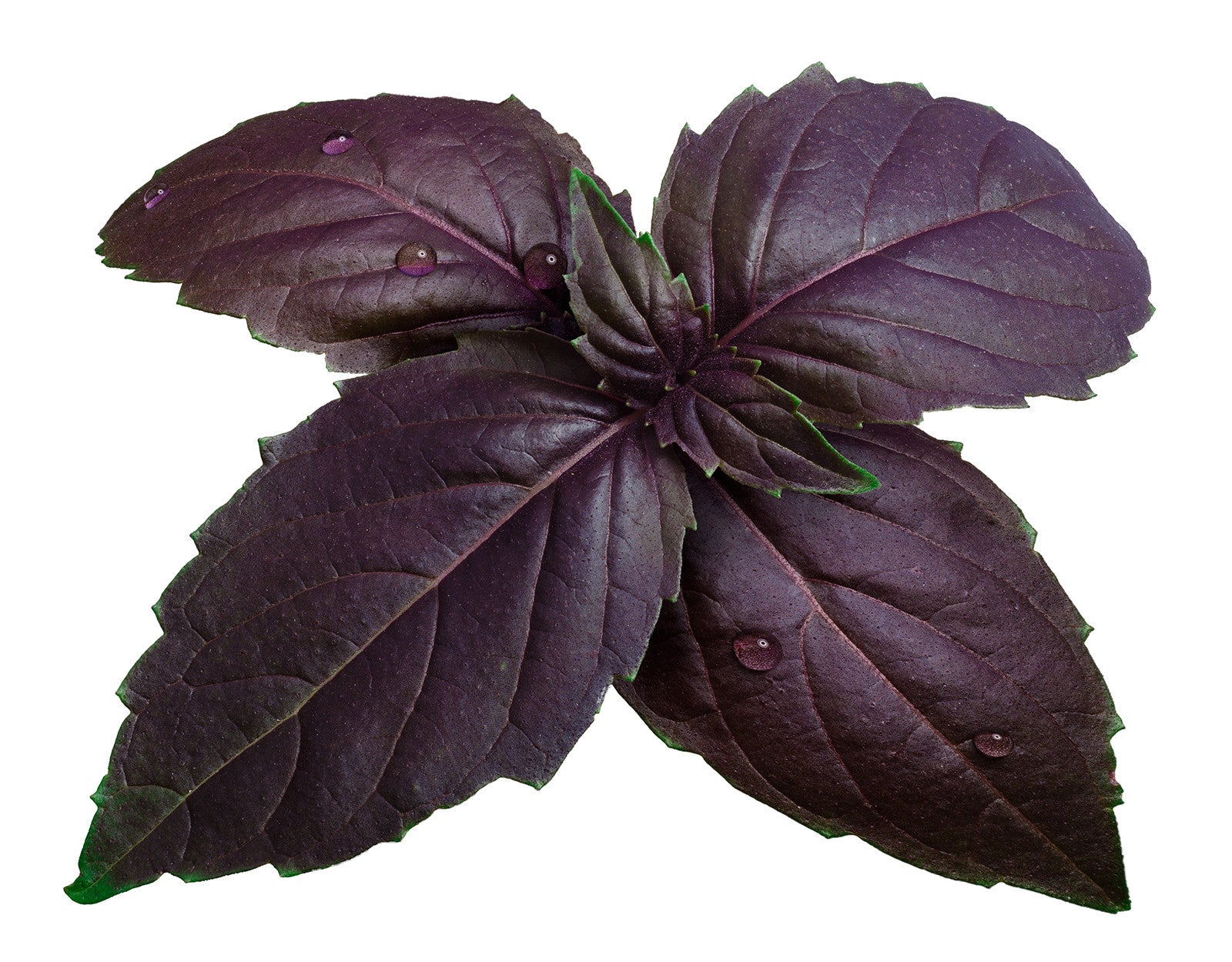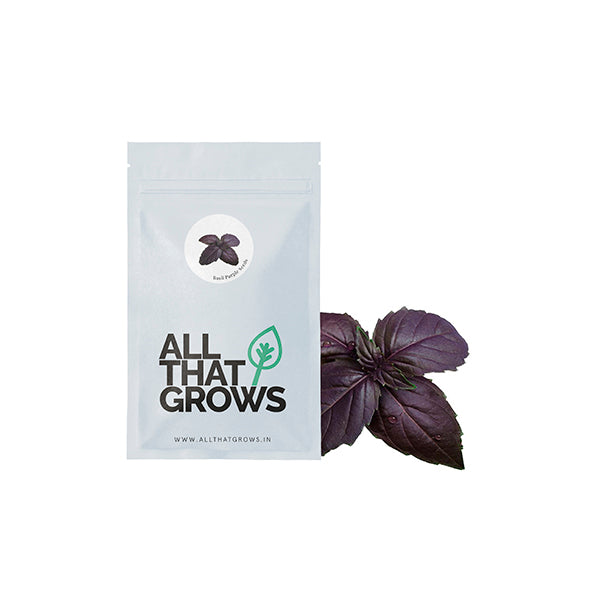



- SOWING
TIMEThroughout the year
- Sowing
DistancePlant to plant - 8'
Row to row - 6' - Fruit
WeightN/A
- Fruit
ShapeN/A
- Days to
maturity30 - 35 days
- Details
- How to sow
- Reviews
With origins in India, Basil has been in cultivation since ancient times. Similar in looks to the mint leaves and in taste to the anise, basil has as many as 60 varieties and one of the very beneficial is the purple colored one. Belonging to the same family of plants as peppermint, the fragrant leaves of basil are full of health-giving nutrients and minerals. More so with the purple variety. The purple basil with its reddish-purple leaves have a quite distinct and individualistic aroma. The color makes it very attractive to look at. The purple color is due the presence of anthocyanins and is particularly rich in Vitamin A, C, and calcium. If you are looking to have flawless skin, luscious hair and want to protect your vision too, then the purple basil should be included more often in your routine. With these specific benefits, it does carry all the goodness of the green basil too. Rich in flavonoids and being anti-bacterial and anti-inflammatory in nature, purple basil makes for a worthy herb that should be consumed without second thoughts. Have purple basil to protect your heart from cardiovascular diseases, reduce the risk of rheumatoid arthritis and troubling bowel conditions. The most popular use of Basil is as the main ingredient in Pesto sauce. Else it can be used as a seasoning herb also. In India basil is popularly added to warm and invigorating beverages for a detoxifying effect.
Planting instructions
Start the seed germination process indoors. Basil is super sensitive to the cold, so whether you are transplanting seedlings from indoors or have plants in the ground, watch the early spring temperatures and cover if necessary.
Plant the seeds/seedlings in the ground about ¼-inch deep and 10 to 12 inches apart. They should rise to around 12 to 24 inches in altitude. For smaller plants, plant farther apart (approximately 16 to 24 inches).
Remember to lift away the flower heads as soon as they sprout to make sure that the leaves keep rising.
Remember to lift away the flower heads as soon as they come out to make sure that the leaves will keep rising.
Growing Requirements
watering
Keep soil consistently moist throught the growing season. Give water when the soil is dry to touch. Water the plant on the base and not over the leaves.
pests
Some of the pests that attack basil leaves are Japanese Beetles Soft-Bodied Insects - such as Aphids, Whiteflies etc. Nematodes Fusarium Wilt These pests can cause white/black spots on the leaves, slim, blotches, yellow leaves or lesions, gray mold etc,
soil
Basil grows well in rich, moist, well-drained loamy soil with a pH of 6 to 7
spot
Basil needs 6 to 8 hours of sun everyday
temperature
Basil is very sensitive to cold and even a light frost will kill it. Basil likes warmer temperatures over 50°F/10°C. Ideal time to plant would be 2 weeks after the last frost in spring.
how to harvest
The best time to harvest is right when the plant begins to bud (before the flowers bloom). Or if you don't have time to harvest any leaves, just pinch off the flowering portion.
If pruned regularly, twelve basil plants will produce 4 to 6 cups of leaves per week. Be sure to only harvest up to 2/3 of the entire plant, so it can continue producing.
The best method for storing basil is freezing. Freezing will prevent the plant from losing any of its flavor. To quick-freeze basil, dry whole sprigs of basil and pack them in airtight plastic bags.
Another storage method is drying the basil (although some of the flavor will be lost).

Customer Reviews
The productiveness of any seed we sell is subject to your local climatic conditions*, the sowing method you adopt, and your commitment to the planting process. We give no warranty, expressed or implied, and are in no way responsible for the produce.
Please note that all our seasonal recommendations/ sowing information is as per the local climatic conditions. *For more information on the optimum conditions required for growing seeds in your region, please contact us at, hello@allthatgrows.in or Whatsapp us at, +91 8544865077
Questions & Answers
Ask a Question-
Is this the same as Indian Holy basil or is it the exotic Basil?
no, its not same .
-
Are they well adapted for indian environment ?what is the right season for planting basil?
Ideal time to plant would be 2 weeks after there last frost in spring.
-
Where are the seeds imported from? Are they non-GMO?
These are non-hybrid, GMO-free and open-pollinated seeds.
-
Are these seeds edible?
Yes.
-
Does it grow indoors?
Yes.
-
Does the plant require any specific soil?
Basil grows well in rich,moist,well drained loamy soil with pH of 6 to 7.
-
Any recommendations on what grows well next to basil?
Any thing as per the season can grow next to baisl..eg you can try coriander,spinach,radish short etc.




Basil Purple Seeds
Seed Type : Non-Hybrid, Open Pollinated and Non-GMO
Plant: Erect and Bushy with small to medium leaves, rich in aroma
Leaf Colour: Purple
Harvesting: 30-35 days from sowing
Sowing time: Throughout the year
Grow this with
With origins in India, Basil has been in cultivation since ancient times. Similar in looks to the mint leaves and in taste to the anise, basil has as many as 60 varieties and one of the very beneficial is the purple colored one. Belonging to the same family of plants as peppermint, the fragrant leaves of basil are full of health-giving nutrients and minerals. More so with the purple variety. The purple basil with its reddish-purple leaves have a quite distinct and individualistic aroma. The color makes it very attractive to look at. The purple color is due the presence of anthocyanins and is particularly rich in Vitamin A, C, and calcium. If you are looking to have flawless skin, luscious hair and want to protect your vision too, then the purple basil should be included more often in your routine. With these specific benefits, it does carry all the goodness of the green basil too. Rich in flavonoids and being anti-bacterial and anti-inflammatory in nature, purple basil makes for a worthy herb that should be consumed without second thoughts. Have purple basil to protect your heart from cardiovascular diseases, reduce the risk of rheumatoid arthritis and troubling bowel conditions. The most popular use of Basil is as the main ingredient in Pesto sauce. Else it can be used as a seasoning herb also. In India basil is popularly added to warm and invigorating beverages for a detoxifying effect.
Seed Type : Non-Hybrid, Open Pollinated and Non-GMO
Plant: Erect and Bushy with small to medium leaves, rich in aroma
Leaf Colour: Purple
Harvesting: 30-35 days from sowing
Sowing time: Throughout the year
- SOWING
TIMEThroughout the year
- Sowing
DistancePlant to plant - 8'
Row to row - 6' - Fruit
WeightN/A
- Fruit
ShapeN/A
- Days to
maturity30 - 35 days
Planting instructions
Start the seed germination process indoors. Basil is super sensitive to the cold, so whether you are transplanting seedlings from indoors or have plants in the ground, watch the early spring temperatures and cover if necessary.
Plant the seeds/seedlings in the ground about ¼-inch deep and 10 to 12 inches apart. They should rise to around 12 to 24 inches in altitude. For smaller plants, plant farther apart (approximately 16 to 24 inches).
Remember to lift away the flower heads as soon as they sprout to make sure that the leaves keep rising.
Remember to lift away the flower heads as soon as they come out to make sure that the leaves will keep rising.
Growing Requirements
watering
Keep soil consistently moist throught the growing season. Give water when the soil is dry to touch. Water the plant on the base and not over the leaves.
pests
Some of the pests that attack basil leaves are Japanese Beetles Soft-Bodied Insects - such as Aphids, Whiteflies etc. Nematodes Fusarium Wilt These pests can cause white/black spots on the leaves, slim, blotches, yellow leaves or lesions, gray mold etc,
soil
Basil grows well in rich, moist, well-drained loamy soil with a pH of 6 to 7
spot
Basil needs 6 to 8 hours of sun everyday
temperature
Basil is very sensitive to cold and even a light frost will kill it. Basil likes warmer temperatures over 50°F/10°C. Ideal time to plant would be 2 weeks after the last frost in spring.
how to harvest
The best time to harvest is right when the plant begins to bud (before the flowers bloom). Or if you don't have time to harvest any leaves, just pinch off the flowering portion.
If pruned regularly, twelve basil plants will produce 4 to 6 cups of leaves per week. Be sure to only harvest up to 2/3 of the entire plant, so it can continue producing.
The best method for storing basil is freezing. Freezing will prevent the plant from losing any of its flavor. To quick-freeze basil, dry whole sprigs of basil and pack them in airtight plastic bags.
Another storage method is drying the basil (although some of the flavor will be lost).



 Sign In
Sign In








